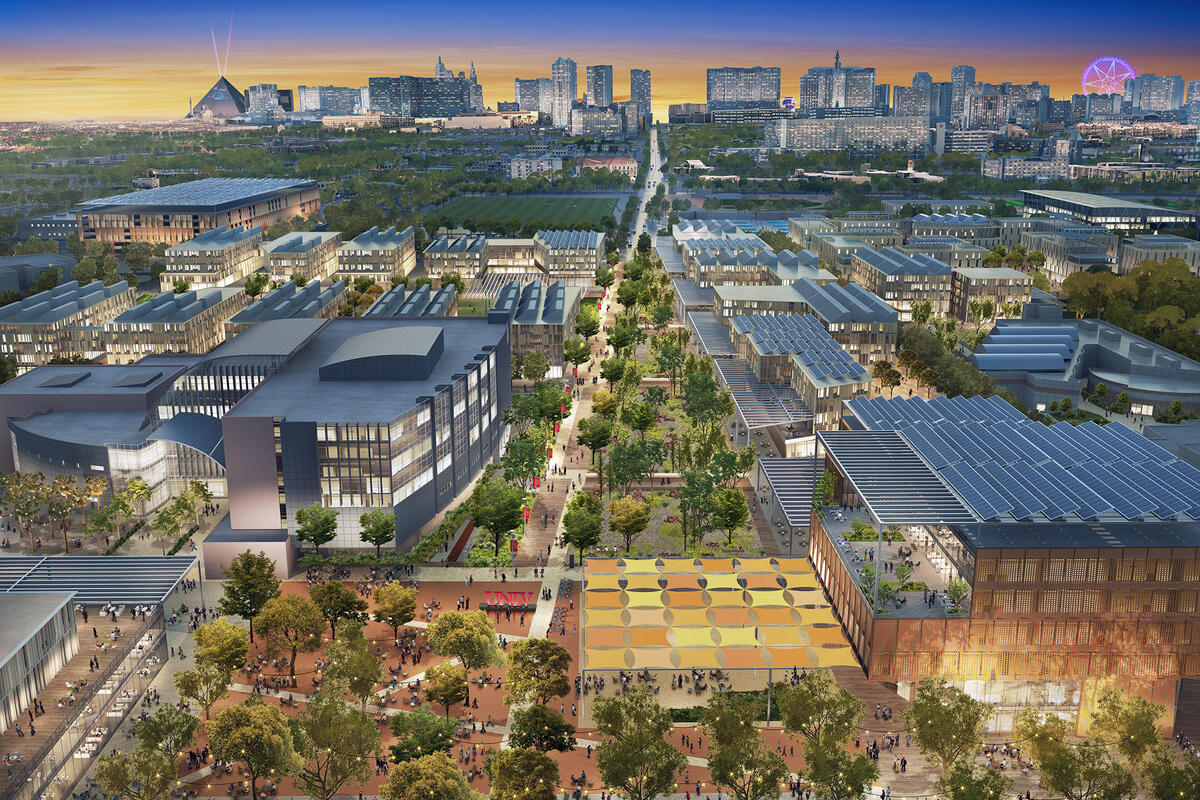
Master Plan: Envisioning the Future of UNLV
View of proposed pedestrian walkway along Lied Library leading to Harmon Ave. entrance.
Campus master plans establish a framework for both short-term (3-5 years) and long-term (10 years and beyond) physical and structural improvements and development on UNLV’s campuses. The plans are dynamic. They allow the flexibility to seize new opportunities that may arise. They align with our programmatic goals and touch all university activities:
- Academics and research
- Energy and infrastructure
- Athletics and recreation
- Open space
- Signage and wayfinding
- Health Sciences
- Transportation and parking
- Sustainability
- Arts and culture
- Residential
2021 Maryland Campus Master Plan
Development Process
At the end of 2019, UNLV engaged the international design firm Sasaki, to update the master plan for the Maryland campus. The plan was developed through a series of engagements with students, faculty, staff, and stakeholders toward realizing eight principles:
- Embrace UNLV’s role as a Top Tier University
- Foster unparalleled student experience
- Celebrate diversity
- Achieve preeminence in health science
- Advance research growth and partnerships
- Engage with Las Vegas
- Promote stewardship
- Enhance connectivity and institutional identity
In 2021, the Board of Regents approved the plan.
Highlights from the 2021 Plan
Neighborhoods
The new master plan organizes colleges into neighborhoods to advance academics and student experience.
University Core: Student academics-focused zone, including the Lied Library, a satellite student union, and Academic Success Center. In the future, Harmon will become the main pedestrian corridor and heart of campus. Including an outdoor plaza that will act as a natural gathering space for students and a venue for outdoor events.
Tropicana District: Enhances student life including housing, dining, and the Student Wellness and Recreation Center.
Harmon District: Enhances the entry from Harmon Rd. to promote connection with the community and create a visual presence. Organizes athletics into a cohesive zone including athletic fields and practice facilities.
Cottage Grove District: Includes theaters, elementary and pre-school, and engineering buildings.
University District: Celebrates our main campus entry at Maryland Parkway. This zone includes the new business school, fine arts building, and museum and becomes the primary connector to the Maryland Corridor.
Thomas and Mack District: Center of large-scale events both for the university and the Las Vegas community.
Flamingo District: Highlights buildings focused on community partnerships including the Stan Fulton Building, Paradise Elementary School, and UNLV/CSUN Preschool.
Connections
The plan reinforces and grows our existing promenades, malls, corridors, and open spaces by:
- Enhancing pedestrian pathways
- Adding desert-smart landscaping and site amenities to make better use of outdoor areas
- Installing bike paths and bike lockers
- Connecting the campus to surrounding transit routes.
Signage and Wayfinding
Planning and Construction has developed new standards for building wayfinding and landmark signs. New signs are currently being installed in parts of campus and down Maryland Parkway to create an identifiable university zone.
Archived Campus Master Plans
The first campus master plan was developed in 1968. Since then, a number of plans have provided the foundation for infrastructure development to make the university what it is today. To request a copy of a past master plan for the Maryland, Shadow Lane, or North campuses, contact Planning and Construction.